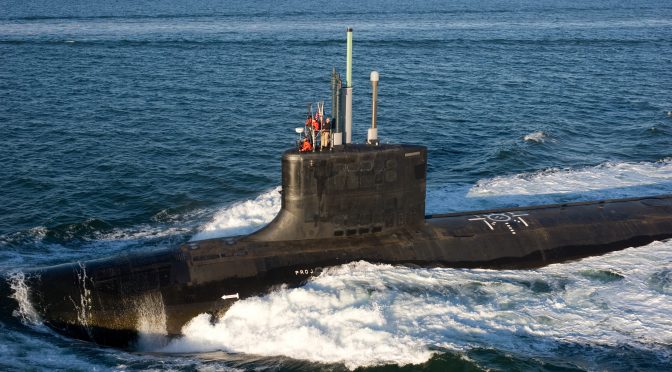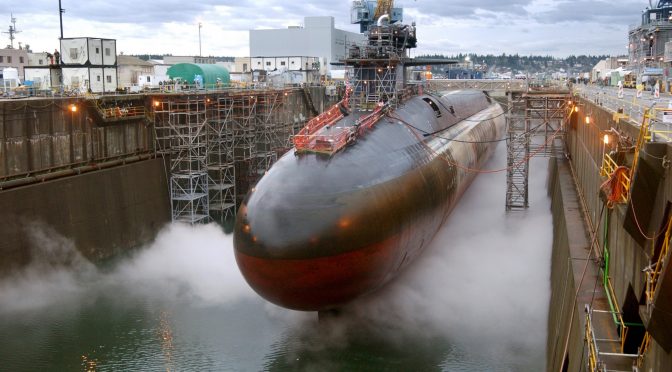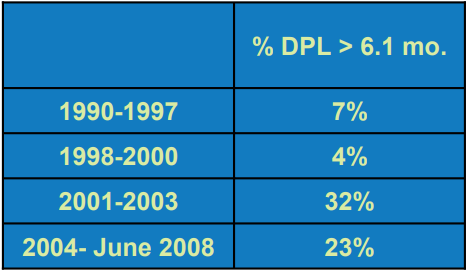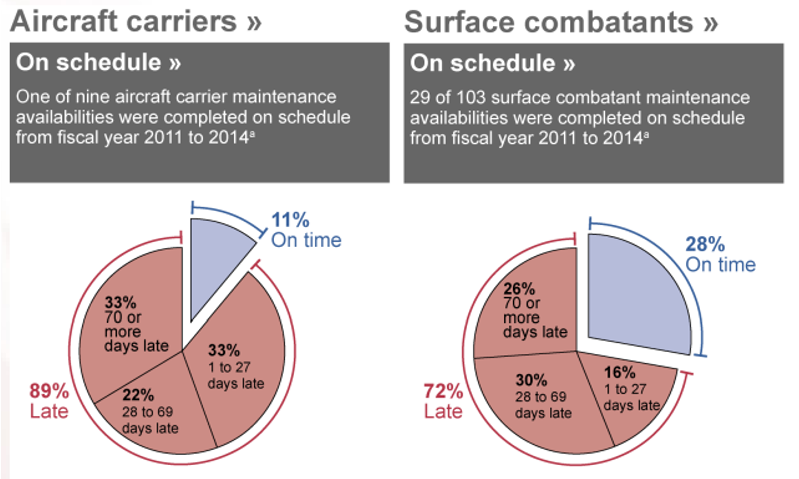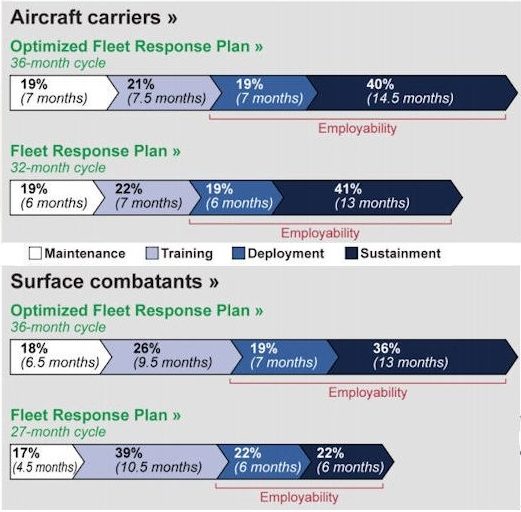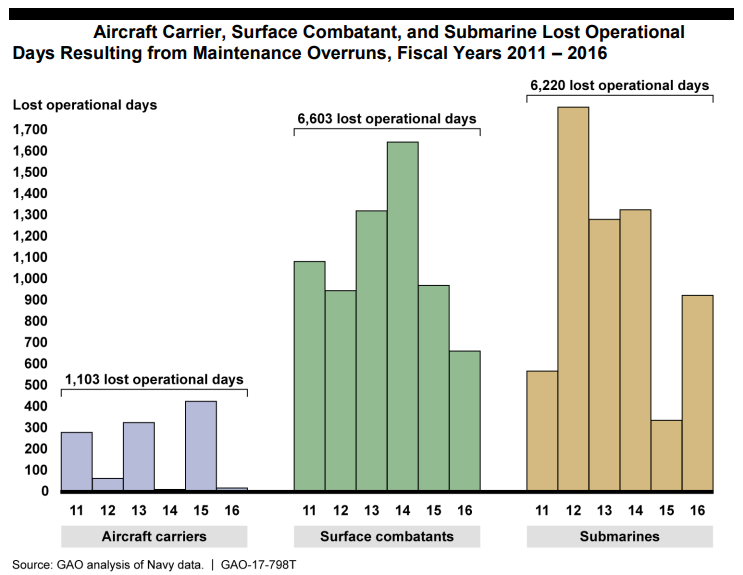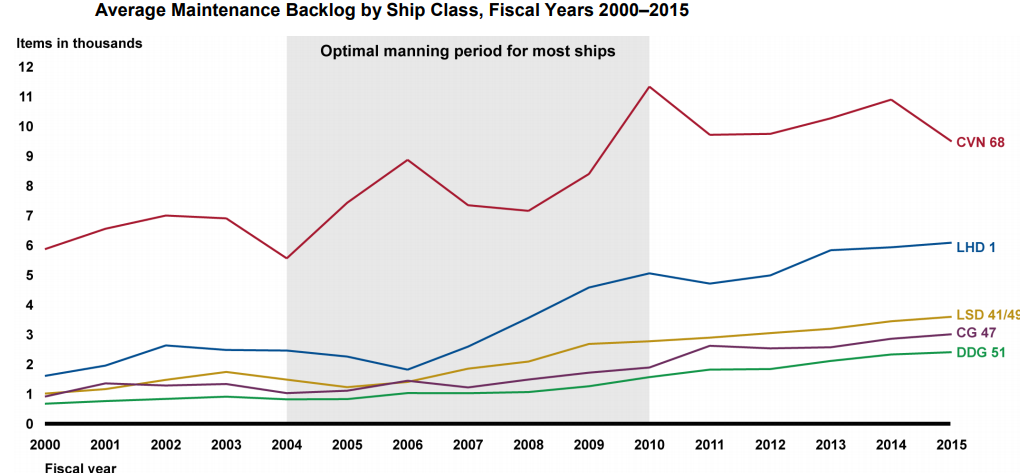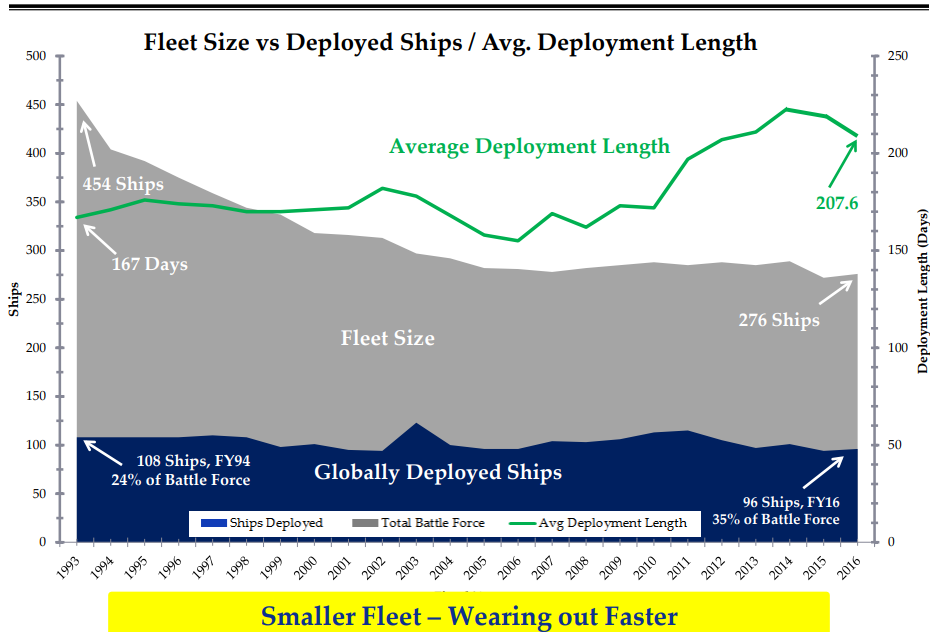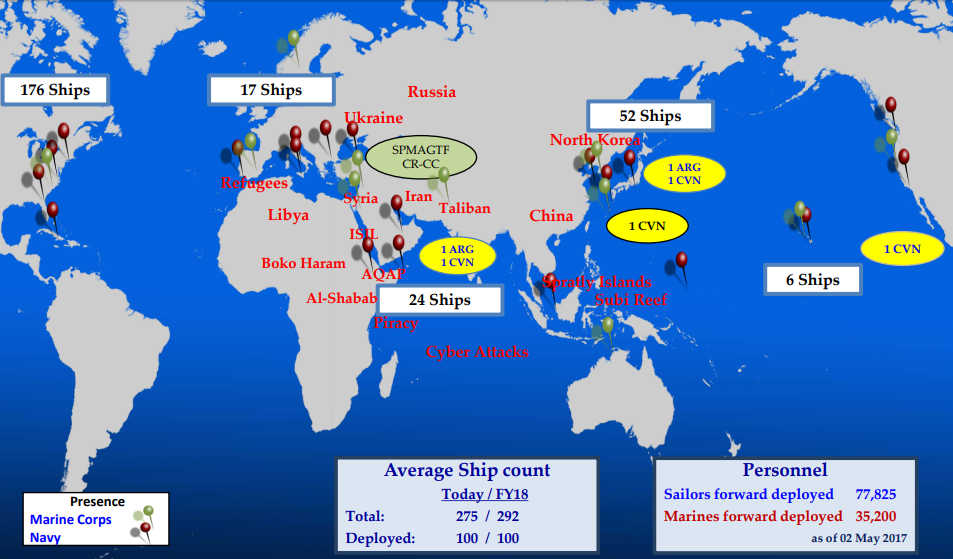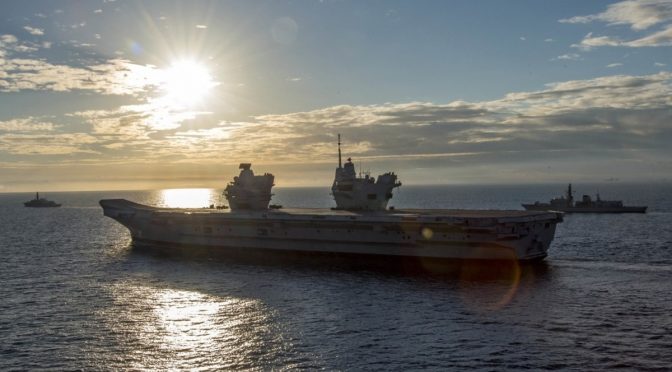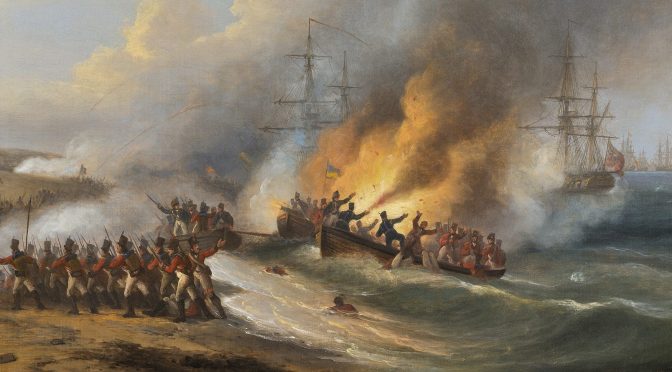This article originally featured in The Naval War College Review in 2008 and is republished with permission. Read it in its original form here. It will be republished in two parts.
By Gabriel Collins, Andrew Erickson, Lyle Goldstein, and William Murray
The U.S. Navy submarine force has set the standard in undersea warfare for at least half a century. America’s submarines made a vital contribution to victory in the Second World War, and they formed an elite force of truly innovative capabilities during the “Cold War at sea” with the Soviet Navy. Since the end of the Cold War, the submarine force has been a leader among U.S. military warfighting communities in transforming itself to remain relevant against militant Islamist extremism and other emerging threats.
In such missions, the submarine force conducts strategic deterrence, intelligence and surveillance, extended-range land attack, and insertion of special forces, in addition to forming the essential backbone of the Navy’s mission of sea control—the all-important, enabling task of maintaining command of the seas for the U.S. armed forces. With the launch of the first of the Virginia class in 2003, the Navy’s position at the forefront of global submarine forces was set for the foreseeable future.
Perhaps partly inspired by the great successes of the U.S. submarine force, navies around the world have invested heavily in undersea warfare, especially in submarine capabilities. China stands out among these as an emerging submarine power. Over the last decade, Beijing has been building four different classes of boats while importing the Kilo-class diesel submarine from Russia in large numbers. Indeed, China’s intense focus on undersea warfare has led some to speculate that a transpacific rivalry is already under way, at least with respect to submarine capabilities. As policy makers in Washington grapple with the challenge of China’s rise, therefore, it may be wise to consider how Beijing is approaching its evolving naval strategy dilemmas. This article examines Chinese views of the American submarine force. As that submarine force constitutes one of the most vital elements of Washington’s overall strategy for establishing and maintaining sea control in times of conflict, Beijing’s assessment of those capabilities may be critical to uncovering the future evolution of this nascent rivalry.
More specifically, then, this research was undertaken for three reasons:
- The U.S. Navy submarine force is thought to represent a key capability for conflict scenarios involving China.
- This part of the U.S. Navy has undertaken major efforts at transformation within a new geostrategic and technological environment.
- The American submarine force represents a rather well-defined warfare area and thus lends itself to a bounded research effort.
Over the last decade, there has been an explosion of publishing in China on all subjects, including strategic and military-technical research. Thus, there are at least five serious journals devoted to naval warfare and dozens of more technically oriented journals.1 In this project, well over a thousand Chinese articles were surveyed, of which approximately 150 were judged worthy of closer scrutiny and analysis by the research team. The danger of circularity—attributing to Chinese analysts ideas that have simply been translated from original English-language sources into Chinese—is real, but one that the research team carefully considered throughout. Most Chinese journals now openly attribute English-language articles to their original sources. By and large, this kind of material (direct translation from English) was not evaluated in this study, in favor of articles that appeared to represent the actual opinions of Chinese naval and defense analysts.
This article is divided into five parts. The first section surveys Chinese reactions to a variety of current issues in the U.S. submarine force, including recent deployments and incidents of special interest. A second section examines Chinese evaluations of specific submarine force capabilities, focusing especially on new factors (e.g., the development of SSGNs) that have been central to transformation efforts. Section three considers some critical historical issues, particularly Chinese perceptions of U.S. submarine operations during the Cold War. A fourth section considers how Chinese analysts believe their antisubmarine forces would match up against the U.S. submarine force. Section five reviews Chinese perceptions regarding the overall future trajectory of the U.S. submarine force. A conclusion summarizes the article and offers policy recommendations.
Overall, this article finds that Chinese naval analysts study the U.S. submarine force in excruciating detail, as concretely manifested in thousands of both strategic and technical articles that focus on it.2 As one Chinese naval analyst puts it, “Nuclear attack subs are the most worthwhile weapons investments because they are the most survivable weapons platforms. . . . During a regional conflict, [U.S.] nuclear attack submarines are the first in and last out.”3 Nevertheless, there is also a keen appreciation that the U.S. Navy is focusing primarily on ongoing military operations in Iraq and Afghanistan. Writing in the official PLA journal 当代海军 (Modern Navy), one analysis declares, “The U.S. Navy’s capabilities to wage war at sea are gradually declining, and open ocean warfare is already not a focal point.”4 Recognizing the potentially major role of the U.S. submarine force in China contingencies, another analyst suggests: “On the basis of a great quantity of research, the PLA [People’s Liberation Army] believes that U.S. nuclear submarines are very quiet, and difficult to discover and counterattack; at the same time, [their] attack power is great, [and] must [be] restrain[ed].”5 Such assessments underline the importance of a closer examination of Chinese perspectives concerning the American submarine force.
Current Developments
In order to give a sense of what Chinese analysts believe to be the trajectory of U.S. submarine force development, it is useful to examine their assessments of two significant recent events: the grounding of the Los Angeles–class submarine USS San Francisco (SSN 711) and the stationing of nuclear-powered submarines on Guam.
The Grounding of the USS San Francisco
The collision of San Francisco with an underwater mountain on 8 January 2005 greatly interested China’s naval press. The articles published then, which prominently feature official U.S. photos of the damaged vessel, express admiration that a submarine that received such damage could have returned to port. This respect is couched in terms of the fundamental strength designed and built into the ship, however, not in terms of the critical factors of crew training and damage control. Author Qi Yaojiu, for example, wrote approximately four months after the incident in a typical article, “In order to investigate battle damage strength, the U.S. undertook strength tests [for submarines] under the conditions of nuclear weapons detonation.” Additionally, “almost every U.S. submarine, before entering into active service, undergoes tests that use underwater explosives to evaluate resistance to battle damage.”6 Notwithstanding this apparent respect, the author recognized that the damage San Francisco incurred would have amounted to a “mission kill,” stating: “If the San Francisco collision had occurred during wartime, and crew members had experienced such wounds, the San Francisco would essentially lose its basic combat effectiveness.”7 A realization that submarines do not have to be destroyed in order to lose combat effectiveness could influence Chinese operational calculations.
Also characteristic of Chinese discussions of San Francisco’s grounding is an undercurrent of bewilderment, asking in effect, “Why were they going so fast?” The tone of analysis implies that such a high-speed transit is somewhat reckless. Thus, one Chinese analyst states that “a nuclear submarine in the process of underwater high speed transit is confronting serious danger” and that “even some U.S. Navy officials expressed that they could not understand the incident.”8 Another author declares, “It is well known in all navies that as soon as a submarine enters international waters in order to protect its stealth, the submarine will not rely on its active sonar. Objectively speaking, a submarine at high speed that is not operating its active sonar is in danger comparable to a vehicle without headlights traveling in the pitch dark.”9 Perhaps because China’s submarine force consists primarily of diesel submarines that rarely make high-speed, long-distance transits, the circumstances surrounding the collision seem peculiar to Chinese naval analysts.
Chinese analyses of the San Francisco incident recognize the United States as a world leader in submarine rescue.10 As one author observes, “Overall, the USN employs the best submarine rescue vehicles and has the most extensive exercises, so its submarine rescue capability leads the world.”11 This appraisal is corroborated in Modern Navy: “Over the last few years, the U.S. Navy has continuously explored submarine rescue methods, and thus strengthened international cooperation, enhancing submarine rescue exercises with its allies. For us this represents a certain inspiration.” Moreover, the Chinese author states, “small groups at various bases are alternatively ready for war or ready to go out and undertake the rescue of an American or allied submarine at any time.”12 Even though the Chinese Navy evidently has extreme respect for the U.S. submarine force, the analyses of the San Francisco incident appear to show awareness that even this elite force can make errors and must invest in cutting-edge rescue technologies.
SSNs in Apra Harbor
As might be expected, China’s naval press has watched the military buildup on Guam with great interest, particularly that of the American submarines.13 A 2004 article in Modern Navy suggests, “The U.S. Navy has stationed three nuclear powered Los Angeles–class attack submarines on Guam. At present, the U.S. military has considered dispatching an additional 6 nuclear submarines. . . .Deployment of such weapons would give the U.S. military considerable capacity to ‘gain the initiative by striking first’ at us from the sea.”14
The same journal a year later described the basing of nuclear-powered attack submarines (SSNs) on Guam in greater detail, observing that the United States officially reestablished Submarine Squadron 15 on Guam under Submarine Group 7 in February 2001 and deployed three nuclear-powered attack submarines there: the first and second in fall 2002 and the third in summer 2004. Moreover, as administered by Commander, Submarine Force Pacific, the submarine group “on the basis of troop deployment plans regularly dispatches 4–5 submarines under its 7th fleet jurisdiction. The duty period of these submarines is ordinarily 6 months. Each submarine can execute missions independently, or can attach to a carrier battle group.”15
The operational significance of stationing SSNs on Guam is not lost on Chinese naval analysts. One observes that “if [a submarine] sets out from Guam, especially in a Taiwan Strait crisis, it may only require 2 days or so.”16 A significant finding of the present study is that even in official journals, Chinese analysts are exploring Guam’s vulnerabilities. The same author notes that Guam, in addition to conferring some advantages to the United States in a Taiwan crisis, also carries self-defense vulnerabilities having strategic implications:
“The U.S. military has still not established a defense system of anti-aircraft, antimissile, and other defense systems on Guam—[there exists] only a pittance of coastal patrol forces. Once there are hostilities, Guam’s defense can only rely on the U.S. Navy’s sea-based missile defense system and Air Force joint operations. Consequently, in wartime, Guam’s defense is still a problem; also, because it is in a special position surrounded on four sides by ocean at the intersection of three major international sea lanes, it is impossible to defend effectively. If the other side’s long-range ballistic missiles, submarine-launched cruise missiles, long-range bombers or maritime special forces operations units, etc., can break through Guam’s peripheral warning and defense, [to] destroy or seriously damage its naval port, airfield, munitions warehouse, and communications system, [then] the entire operational system of America in the Pacific Theater can become ineffective, its sustained warfare capability can greatly fall short of requirements [and] its resolution and dynamics of military intervention would have to change.”17
Regardless of the validity of their specific claims, then, it is clear that some Chinese analysts perceive Guam to be vulnerable to offensive attacks.
U.S. Navy Capabilities
Having set the scene by reviewing major submarine force developments noted by Chinese analysts, we now turn to a more comprehensive survey of the major American capabilities that have attracted their attention. These include nuclear powered cruise missile–armed submarines (SSGNs) and Tomahawk cruise missiles, Trident submarines, fast attack submarines, sensors and systems, and research and development.
SSGNs and Tomahawks
Chinese analyses demonstrate interest in the Navy’s four new SSGNs, their conversion from Ohio-class ballistic-missile submarines, and their mission areas.18 A fairly typical article observes that:
“refitting focal points are refitting the first 1–2 of 24 ballistic missile launch tubes for the use of special forces; tubes 3–10 into special forces use or for Tomahawk cruise missiles; [and] tubes 11–24 for Tomahawk cruise missiles. After refitting, the submarine can carry 154 Tomahawk cruise missiles, and 66 special forces personnel, a dock/shipyard cover, a frogman transport ship (SDV), and an advanced Seal Transport System (ASDS).”19
Although they clearly recognize the potential value of an SSGN’s embarked special operations forces, Chinese analysts appear to be much more impressed by the implications of one SSGN’s potentially large inventory of Tomahawk cruise missiles and the high readiness rate that SSGNs will be able to maintain. One perceptive article observes that these features will allow other ships to focus on different mission areas:
“After being refitted, SSGNs will be deployed 65% of the time each year on average. . . . As such, the USN will always have at least 2 SSGNs ready for battle at any time, and in wartime, 1 SSGN can take over the duties of many attack submarines and surface ships. Once the SSGN goes into service, this will significantly reduce the land attack burden shouldered by the surface fleet and allow it to focus on providing air defense against missile threats. At the same time, the SSGN will reduce the land attack role of SSNs, enabling them to concentrate on anti-surface and ASW [antisubmarine warfare] missions.”
The same analysis also recognizes with some alarm that “it is conceivable that in the future the arsenal ships could from a safe distance simultaneously rain 500 or more guided missiles upon several points of an enemy’s territory. Using [the SSGN] would be stealthier and faster than an air raid by carrier based aircraft and would also avoid pilot losses.”20
Chinese literature on SSGNs suggests anxiety regarding this capability and what it may mean for Chinese forces. One analysis calculates that SSGNs will allow the United States to engage in saturation attacks: “The ground forces that have relied on the traditional deception against air attack, such as fake targets and positions, will be severely tested under future conditions in which the U.S. armed forces are able to employ saturation attacks by low-cost [cruise missiles].”21 Another analyst, however, points out that Tomahawks are expensive, estimating that Tactical Tomahawks cost anywhere between $5.7 and 8 million dollars a round.22 One Chinese lesson from the Kosovo conflict was that the United States does not possess an infinite inventory of Tomahawk cruise missiles; even in that relatively minor conflict, it adjusted its weapons stocks to cope with apparent resource limitations.23
Trident Submarines
Chinese writings about SSBN capabilities express concern about potential U.S. plans to place conventional warheads on submarine-launched ballistic missiles. One scholar writes that “the new Trident II D5 can achieve a CEP [circular error probable—generally, accuracy] of nine meters. Therefore, as far as point targets are concerned, there already exists the ability to achieve nuclear destruction with a conventional warhead.” This accuracy, he worries, might raise the risk of war overall: “One can see that through lowering one’s own barriers to war, one can more realistically deter the enemy. This undoubtedly reduces war’s actual combat threshold.”24 This may reflect a Chinese concern that Trident conventionalization could give the United States more ability to coerce China in a variety of combat scenarios.
The nuclear deterrence provided by American nuclear-powered ballistic-missile submarines (SSBNs) is well recognized in the majority of Chinese writings, as is the significance of the shifting of five Ohio-class SSBNs (USS Pennsylvania, Kentucky, Nebraska, Louisiana, and Maine) from the Atlantic to Pacific fleets from 2002 to 2005. This transfer occurred as the four oldest Ohio-class SSBNs, which had all been stationed in the Pacific, were temporarily taken out of service for conversion to SSGNs; the two transactions effectively rebalanced the American SSBN force from a Pacific/Atlantic ratio of ten/eight to nine/five.25
Fast Attack Submarines
Chinese observers are intensely interested in and closely follow other modern U.S. nuclear submarines, including the USS Jimmy Carter, Seawolf, and Hawaii. Highly detailed, full-page color photos of Seawolf– and Virginia-class submarines appear in China’s most prominent naval journals. These photos are usually accompanied by articles that imply an advanced state of technology and advanced acoustic quieting. Thus, for example, Seawolf is described as having
“an X type stern, [sic] employ[ing] a non-circulating main pump SbW [sic] pressurized water reactor, rel[ying] on natural circulation [of cooling water], thereby reducing noise; us[ing] an advanced pump jet propulsor, [thereby] reducing noise, us[ing] anechoic tiles on the hull. Anechoic tiles can absorb the enemy’s active sonar survey waves as well as both separate and reduce the submarine’s own noise radiation. Moreover, this ship’s own machinery power equipment also employs [sound isolation] technology. These measures reduce the Seawolf-class’s noise level to 95 decibels, making it the world’s quietest submarine (ocean background noise is 90 decibels, Kilo 636 noise is 105 decibels).”26
Additionally, Chinese authors believe Seawolf possesses “beyond-first-class performance” and is regarded as the most sophisticated and lethal submarine yet to go to sea, despite its “tortuous development history.”27
The Chinese also respect Virginia-class submarines for their advanced technology and quietness. An author in Modern Navy states that “compared with the Sea Wolf–class submarine, the Virginia is slower and carries fewer weapons, but is just as quiet. Its acoustic signature is lower than that of the improved model of Russia’s Akula-class attack submarine and Russia’s fourth-generation attack submarine that will hereafter be in active service.”28 Another analyst, in discussing the Virginia class’s acoustic achievements, reports, “The Virginia-class has been called ‘the world’s quietest submarine,’ with a cruising sound level that is only 1/10 that emitted by a Los Angeles class boat pierside.”29
The techniques used to build Virginia and its sister ships also evoke respect, with one author noting, “The use of modular construction has been a major breakthrough in the construction of the Virginia-class SSN. . . . This construction method is a revolutionary breakthrough compared to the methods used to build the Los Angeles–class.”30 Modular construction is widely perceived as a tremendous advantage, allowing the United States to “promptly design and build new nuclear submarines on the basis of new circumstances and requirements.”31 Plans for Virginia, it is implied, having been generated by computer-aided design tools and relying on modular construction, could be used as the basis of a new SSBN design.32 Chinese authors argue that Virginia’s impressive technology allows it to “scout, reconnoiter, and keep watch from a concealed position using its modern sensors to gather intelligence; analyze it; fix radar positions, missile bases, and command centers; as well as watch and track warship movements.”33 The Virginia class is thus seen as “a completely new attitude emerging on the world military combat arena.”34 Some Chinese analysts believe “the U.S. will keep building Virginia class boats and the final number could exceed 30.”35
Los Angeles–class submarines receive significant attention from Chinese authors. One article on this class notes, “The American Navy believes that: nuclear attack submarines are the most worthwhile weapons investments because they are the most survivable weapons platforms, have the advantage of being stealthy, and have become one of the premier threats at sea.”36 Another author rates their performance as “outstanding,” with the reservation that although they have superior weaponry, they “might not [have proved] an effective counter to new types of Soviet nuclear submarines.” This impending disparity, in turn, is credited with precipitating U.S. follow-on designs.37 Still another observer notes that Los Angeles–class submarines are aging: “By the year 2020, the U.S. military intends to have built 30 nuclear attack submarines. However, by the year 2016, all of the Los Angeles–class submarines will exceed 30 years of service life”; the writer emphasizes the great expense of replacing them with Virginia-class vessels.38
Chinese naval observers regard American torpedo technology highly. Noting an enviable six decades of torpedo experience, one Chinese author observes, “Since World War II and for a relatively long period, U.S. torpedo technology has always been among the best in the world.”39 With specific reference to the Mark 48 heavyweight torpedo, another analyst assesses that “the [Mark 48] torpedo’s outstanding effectiveness in all combat circumstances has been proven and it can be used to attack surface ships, nuclear submarines, and also diesel electric submarines.”40 The same author describes the aggressive U.S. torpedo-testing program: “The USN has already carried out more than 6500 exercises and warshot firings [with the Mark 48], in addition to 20,000 simulations and 9 million mathematical simulations, so that this torpedo reaches a high state of reliability.” Perhaps in reference to the sinking of Russian Oscar-class submarine Kursk, and also as part of an overall effort to improve submarine safety consciousness, this analyst later observes that “the [Mark 48] system has been in active service since 1982 and there have been no safety accidents.”
Not every Chinese analyst would readily agree that the Mark 48 torpedo or its Advanced Capability (ADCAP) variant is especially fearsome. In a 2005 article, a Chinese author flatly stated, “Traditional heavy-weight torpedoes practically have no way to cope with modern diesel submarines in shallow waters.”41 The author notes that “shallow waters constitute a very acoustically complex warfare environment” and that the U.S. Navy has allocated significant resources to developing sonars suitable for littoral combat against diesel submarines.42 Another analyst, however, appreciates the U.S. Navy’s ability to upgrade the weapon: “At the moment, [the Mark 48] torpedo is still being upgraded, so that it can correspond to the challenges associated with shallow water environments and threat—it is expected to be in service with the USN until 2025.”43
The authors are research faculty in the Center for Naval Warfare Studies at the Naval War College in Newport, Rhode Island. They are members (Dr. Goldstein is the founding director) of the College’s China Maritime Studies Institute. The opinions expressed in this report are those of the authors alone and not the assessments of the U.S. Navy or any other entity of the U.S. government.
References
- This article draws extensively on five of the serious PRC professional publications concerned with naval warfare: 当代海军 (Modern Navy), 人民海军 (People’s Navy), 舰船知识(Naval and Merchant Ships), 舰载 武器 (Shipborne Weapons), and 现代舰船 (Modern Ships). Modern Navy is a monthly magazine published by the official PLAN newspaper People’s Navy, which is the daily newspaper published by the Political Department of China’s navy. Modern Navy offers articles that are often concrete and revealing of important capabilities, initiatives, and exercises. See, for example, 徐红明, 刘新民 [Xu Hongming and Liu Xinmin], “‘敌后’布 雷–中国海军某潜艇突破反潜编队训练 目击记” [Lay Mines “In the Enemy’s Rear Area”: An Eyewitness Account of a Certain PLAN Submarine Exercise Involving Breaking Through Antisubmarine Formations], 当代海军 [Modern Navy], no. 4 (2003), p. 38. 舰船知识 (Naval and Merchant Ships), a semitechnical monthly publication of the Chinese Society of Naval Architecture and Marine Engineering, has directly involved a retired PLA Navy rear admiral, Zheng Ming, formerly head of the PLA Navy’s Equipment Department, in its publication activities. See “我刊召开作者, 读者, 编者座谈会” [Our Journal Convenes a Discussion among Writers, Readers and Editors], 舰船知识 [Naval and Merchant Ships] (August 2006), p. 8. An active-duty PLA Navy admiral has contributed to the journal. See 杨毅 [Yang Yi], “谁 的潜艇今后说了算?” [Who Can Estimate the Future Number of Submarines?], 舰 船知识 [Naval and Merchant Ships] (July 2006), p. 28. Shipborne Weapons and Modern Ships are both monthly journals published by the state-owned China Shipbuilding Industry Corporation (CSIC), China’s largest designer, manufacturer, and trader of military and civilian vessels and related engineering and equipment. In addition to these naval-oriented publications, 中国军事 科学 (China Military Science) is published by the PLA’s Academy of Military Sciences.
- Because of the difficulty in conclusively identifying the authors of many Chinese writings on naval issues, this article will use a very broad definition of “naval analyst” —namely, one who engages in research and publication concerning naval affairs.
- 钱晋 [Qian Jin], “影子 ‘前锋’ 洛杉矶: 我伴 航母走天涯” [The Shadowy Vanguard Los Angeles Class: Escorting Carriers to the Far Corners of the Earth], 舰船知识 [Naval and Merchant Ships] (August 2002), pp. 38–41.
- 张建平, 高倚天 [Zhang Jianping and Gao Yitian], “透视美海军 2035 年: 远 景规划” [Perspective on the U.S. Navy in 2035: Prospective Plans], 当代海军 [Modern Navy] (August 2005), p. 37.
- 林长盛 [Lin Changcheng], “潜龙在渊: 解放军水雷兵器的现状与发展” [The Hidden Dragon in the Deep: The Present Situation and Development of PLA Mine Weaponry], 国际展望 [World Outlook], no. 9 (May 2005), p. 32.
- 齐耀久 [Qi Yaojiu], “‘旧金山’号核潜艇触 礁事故的再思考” [Reflecting Again on the San Francisco Nuclear Submarine Collision Accident], 现代舰船 [Modern Ships] (July 2005), p. 41.
- Ibid., p. 42.
- Ibid., pp. 41–42.
- 止戈 [Zhi Ge], “旧金山’号核潜艇事故分 析” [Analysis of the San Francisco Nuclear Submarine Accident], 舰船知识 [Naval and Merchant Ships] (March 2005), p. 59.
- 孙晔飞, 聂其武 [Sun Yefei and Nie Qiwu], “从美核潜艇出事: 瞧潜艇非战时事故规 律” [Looking at Patterns of Nonwar Submarine Accidents, from the Perspective of 15 Collins et al.: Chinese Evaluations of the U.S. Navy Submarine Force Published by U.S. Naval War College Digital Commons, 2018 82 naval war college review collins, erickson, goldstein, & murray 83 the U.S. Nuclear Submarine Incident], 当代 海军 [Modern Navy] (March 2005), p. 20.
- 临河 [Lin He], “常备不懈—美国海军潜 艇救生及启示” [Always Prepared: The Inspiration of the U.S. Navy’s Submarine Rescue Cooperation], 现代舰船 [Modern Ships] (May 2004), p. 11.
- Ibid., pp. 9–11.
- Among the many articles that examine the U.S. military buildup on Guam are台风 [Tai Feng], “中国需要反潜巡逻机马?” [Does China Need Antisubmarine Patrol Aircraft?], 舰载武器 [Shipborne Weapons], no. 3 (March 2005), pp. 70–75; “美国陈兵关岛虎视台海” [U.S. Troops Deployed in Guam Vigorously Watch the Taiwan Strait], 世界新闻报 [World News Report], 15 February 2001; “美核攻击 潜艇欲驻关岛意何为” [Why America Stations Nuclear Attack Submarines in Guam], 信息日报 [NewsDaily], 3 November 2000, p. 22; “美国核潜艇关岛触礁” [U.S. Nuclear Submarine Strikes a Reef near Guam], 环 球时报 [World Times], 20 January 2005; Zhao Xiaozhuo, “The United States Does Not Want to Get Involved in a Crisis in the Taiwan Strait,” Huanqiu Shibao, 3 January 2005, FBIS CPP20050114000176; “核潜艇进 关岛: 美国居心叵测” [Nuclear Submarines Enter Guam: The U.S. Harbors Unfathomable, Evil Intentions], 中国国防报 [China National Defense News], 2 April 2002, p. B04.
- 李杰 [Li Jie], “对美系列海上演习之思考” [Reflections on the Series of U.S. Exercises at Sea], 当代海军 [Modern Navy] (September 2004), pp. 20–21.
- 赵宇 [Zhao Yu], “全景扫描: 美太平洋第 七舰队战力, 中部” [Scanning the Entire Panorama: The Combat Power of the U.S. Pacific Seventh Fleet (middle part)], 当代海军 [Modern Navy] (February 2005), pp. 53–57.
- 韩江波 [Han Jiangbo], “关岛—美军控制 西太平洋作战体系的‘纲’” [Guam: The “Key Link” in the U.S. Military System to Control the Western Pacific], 当代海军 [Modern Navy] (December 2006), p. 33.
- Ibid., p. 34.
- For the SSGN program and related operational opportunities and issues, see Charles D. Sykora, “SSGN: A Transformation Limited by Legacy Command and Control,” Naval War College Review 59, no. 1 (Winter 2006), pp. 41–62.
- 杨修水 [Yang Xiushui], “2010, 世界大洋的新 生代—核潜艇篇” [In 2010, a New Era on the World’s Oceans: Writing on Nuclear Submarines], 当代海军 [Modern Navy], no. 9 (September 2004), pp. 50–55.
- 天鹰 [Tian Ying], “SSGN 即将面世的水下武 库舰” [The SSGN Will Soon Be the World’s Premier Underwater Arsenal], 舰载武器 [Shipborne Weapons] (December 2004), p. 67.
- 李文盛, 程建良 [Li Wensheng and Cheng Jianliang], “威胁自海上来: 美海军对陆火力 突击能力的发展特点及影响” [Threat from the Sea: Development and Implications of Development Trends in the U.S. Navy’s Surprise Strike Firepower against the Land], 舰载武器 [Shipborne Weapons] (March 2003), p. 20.
- “美国海军拟部署战术‘战斧’导弹” [U.S. Navy Intends to Deploy Tactical Tomahawk], 舰载武器 [Shipborne Weapons] (January 2000), p. 36.
- See Li Wensheng and Cheng Jianliang, “Threat from the Sea,” p. 17.
- Both quotes in this paragraph are from董 露, 郭纲, 李文胜 [Dong Lu, Guo Gang, and Li Wensheng], “析美国战略导弹常规 改装的动因及影响” [Analysis on the Motives and Effects of U.S. Strategic Missiles Armed with Conventional Warheads], 中 国宇航学会 [China Space Institute] (paper distributed but not presented at Tenth PIIC Beijing Seminar on International Security, Program for Science and National Security Studies and Institute of Applied Physics and Computational Mathematics, Xiamen, China, 25–28 September 2006).
- See, for example, 朱伟 [Zhu Wei], “美 9 艘战 略核潜艇聚集太平洋” [Nine U.S. Strategic Nuclear-Powered Submarines Assembled in the Pacific Ocean], 当代海军 [Modern Navy] (November 2005), pp. 58–59. In addition to commenting on the significance of the United States transferring SSBNs and SSNs from the Atlantic to the Pacific oceans, this lengthy, wide-ranging article also devotes substantial space to alleged aging problems in the W76 nuclear warhead, criticizes as overly large and unstable the U.S. nuclear stockpile, and decries the negative effects of all this on Asia-Pacific security.
- Yang Xiushui, “In 2010, a New Era on the World’s Oceans,” p. 50.
- 汪玉, 姚耀中 [Wang Yu and Yao Yao, eds.], 世界海军潜艇 [World Naval Submarines] (Beijing: 国防工业出版社 [National Defense Industry Press], 2006), p. 127.
- 河山 [He Shan], “‘弗吉尼亚’号能否成为新 世纪海上霸王?” [Can the Virginia Class Become the New Century’s Oceanic Hegemon?], 当代海军 [Modern Navy] (October 2004), p. 21.
- “‘弗吉尼亚’ 潜艇浮出水面” [Launching of the Virginia Class], 现代军事 [Contemporary Military Affairs] (October 2004), p. 23.
- Only three Sea Wolf–class submarines were ever built. The Cold War’s end made it impossible to justify construction of additional hulls, because this submarine had been optimized for combating the Soviet Navy. Wang Yu and Yao Yao, eds., World Naval Submarines, p. 129.
- Ibid., p. 29.
- 陈位昊 [Chen Weihao], “美国海军调整 部署: 美国核潜艇云集太平洋妄图威摄 中国”[The U.S. Navy Adjusts Deployment: U.S. Submarines Converging in the Pacific Vainly Attempt to Deter China], 国际展望 [World Outlook], no. 6 (March 2006), p. 13.
- 曹家伟 [Cao Jiawei], “杀向近海—美海军弗 吉尼亚级新型攻击型核潜艇”[Fighting into the Littoral: The U.S. Navy’s Virginia-Class Nuclear Attack Submarine], 环球军事 [Global Military Affairs], no. 18 (2004), pp. 26–29.
- Ibid.
- He Shan, “Can the Virginia Class Become the New Century’s Oceanic Hegemon?” p. 21.
- Qian Jin, “The Shadowy Vanguard Los Angeles Class,” pp. 38–41.
- Wang Yu and Yao Yao, eds., World Naval Submarines, p. 121.
- 世画 [Shi Hua], “世界未来潜艇发展前瞻” [World Submarine Development Prospects], 海事大观 [Maritime Spectacle] (January 2007), p. 86.
- 黄龙华 [Huang Longhua], “潜艇克星: 世界 反潜鱼雷概览” [The Star for Subduing Submarines: A Survey of World ASW Torpedoes], 环球军事 [Global Military Affairs] (August 2006), p. 48.
- 崔峰 [Cui Feng], “Mk48 ADCAP: 美国海军主 战重刑鱼雷” [The Mk 48 ADCAP: The U.S. Navy’s Primary Combat Heavyweight Torpedo], 现代舰船 [Modern Ships], no. 4 (2004), p. 31.
- 刘伟[Liu Wei], “外军的鱼雷及鱼雷防御技 术” [Foreign Torpedo and Torpedo Defense Technology], 现代军事 [Contemporary Military Affairs] (May 2005), pp. 34–37.
- Ibid.
- Ibid. This three-page article is accompanied by full-color pictures of Mark 48 ADCAP circuit boards, torpedo body sections, detailed propulsion system schematic diagrams, and tables with performance criteria.
Featured Image: ATLANTIC OCEAN (April 7, 2012) The Virginia-class attack submarine Pre-Commissioning Unit (PCU) Mississippi (SSN 782) conducts alpha trials in the Atlantic Ocean. (U.S. Navy photo courtesy of General Dynamics Electric Boat/Released)

